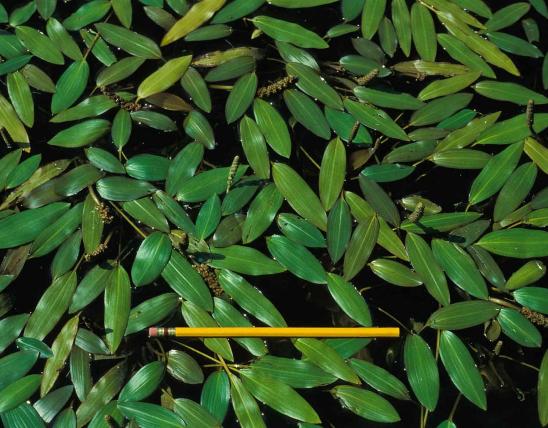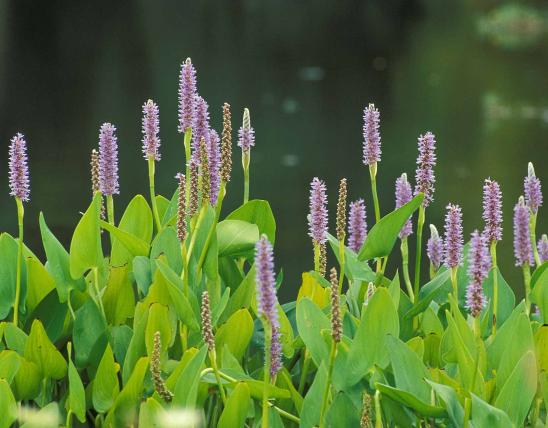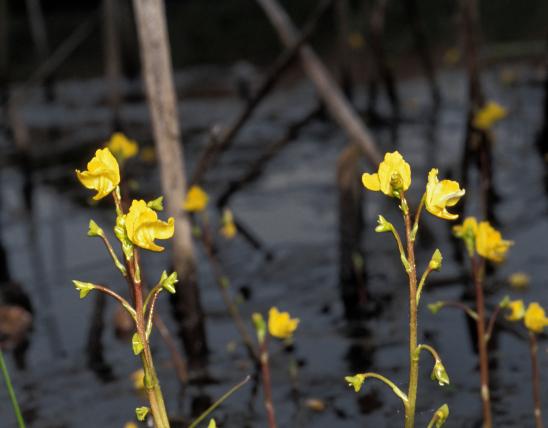
Water star-grass is an attractive underwater plant. When it flowers, it’s easy to identify. Each bloom is a bright yellow star with six narrow petal lobes, raised just above the water surface.
Herbaceous perennial with slender, elongate, branching stems. The plants grow together in loose masses, floating or rooted on muddy shores. They reproduce by seeds and fragmentation of stems.
Leaves are mostly alternate, tapering at the base and lacking a leaf stem (petiole), grasslike (linear), to about 6 inches long. The leaves have no well-defined midvein.
Flowers single, technically stalkless, arising from the leaf axils. Petals are yellow, fused at the base into a tube, which is so long it looks like a flower stalk. The tube is usually ½–3 inches long, with a leafy green sheath (spathe) wrapped around the base. The petal lobes are narrow. Blooms June–September. Plants in deeper water tend to have fewer flowers, while those closer to shore or stranded on mud banks may have many. Flowering occurs mostly in quiet backwaters or in situations where the plants colonize muddy banks. The flowers only bloom for a single day.
Similar species: Certain species of pondweeds (Potamogeton spp.) are somewhat similar to nonflowering water star-grass plants, but pondweed leaves have a prominent midvein, while water star-grass leaves do not.
Missouri has 4 other species in the mud plantain genus (Heteranthera). This is the only one with linear leaves that lack leaf stems, with yellow petals, and with stamens all the same length.
Length: stems to 6 feet.
Common in the Ozark and Ozark border regions; sporadic north of the Missouri River. Native to most of the continental United States.
Habitat and Conservation
Grows as a submerged or floating-leaved aquatic plant in streams, rivers, spring branches, sloughs, and (rarely) along lake margins. It is frequently found rooting in mud. It often forms large, leafy, submerged masses in the cool, fast-flowing waters of streams and spring branches in the Ozarks. However, it can also be found in warmer, more sluggish waters as well.
Status
Native submerged or floating-leaved aquatic shoreline plant.
Human Connections
Water star-grass is a good cover plant for pond shorelines, and the dainty yellow flowers are a pleasant accent. It is also recommended as an attractive and hardy aquarium plant. It tolerates a wide range of water temperature, depth, and flow. It does well in alkaline water with partial to full illumination. It is undemanding, tolerates cold, and propagates readily from cuttings or divisions.
Like many plants that have the word “grass” in their common name, this species is not actually in the grass family; it simply has narrow, linear, grasslike leaves. In cases like this, botanists often try to convey that it’s not a true grass by using a hyphen (“star-grass”) or closing up the space (“stargrass”) in the common name.
Ecosystem Connections
Water star-grass provides food for waterfowl and mammals, which eat the foliage. Ducks, especially, like to nibble on the leaves. It also provides cover for fish and other aquatic animals.
Insects that feed on water star-grass include aphids and, apparently, certain butterfly or moth species, beetles, flies, and caddisflies.
This is one of the plants that typically produces certain flowers that never open but still can produce abundant seeds. These are called cleistogamous flowers (cleisto- meaning closed, as in the word “cloister”; -gamous meaning marriage, as in the word “monogamy”). It’s pronounced kly-STAH-guh-muss. In water star-grass, the cleistogamous flowers are entirely enclosed within protective leaflike structures (spathes), and they fertilize themselves. There’s another plant you know that’s famous for cleistogamy: violets. Look at the base of a violet plant, and you’ll usually find several pale, never-opening flower buds and their resulting seed capsules.































